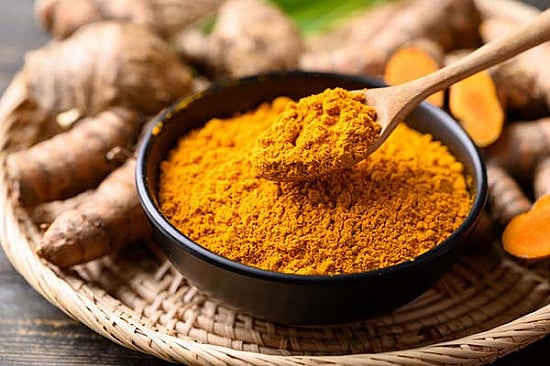Turmeric, derived from the rhizome of Curcuma longa, a member of the ginger family, boasts a rich history of medicinal use, particularly in Ayurvedic and Traditional Chinese Medicine. Its vibrant yellow color comes from curcumin, the primary bioactive compound responsible for the spice’s numerous health benefits. While turmeric has long been a staple in culinary traditions, modern research has elucidated its diverse pharmacological properties, including anti-inflammatory, antioxidant, anticancer, and antimicrobial effects. These findings have propelled turmeric into the spotlight as a complementary therapy for a wide array of health conditions, ranging from chronic inflammation to metabolic disorders.
The potent anti-inflammatory action of curcumin stems from its ability to modulate key inflammatory pathways. It inhibits molecules like NF-κB and COX-2, thereby reducing the production of pro-inflammatory cytokines such as IL-6 and TNF-α. This mechanism underlies its efficacy in managing conditions like arthritis and inflammatory bowel disease. Studies have shown that curcumin supplementation can significantly alleviate pain and swelling in arthritis patients, offering comparable relief to NSAIDs but with a reduced risk of side effects. Similarly, in IBD, curcumin has demonstrated the potential to reduce gut inflammation and promote remission.
Oxidative stress, an imbalance between free radicals and antioxidants, plays a significant role in aging and chronic diseases. Curcumin acts as a powerful antioxidant, neutralizing free radicals and boosting the activity of antioxidant enzymes like superoxide dismutase (SOD) and glutathione peroxidase. This antioxidant capacity contributes to its neuroprotective effects, potentially delaying the progression of neurodegenerative diseases like Alzheimer’s and Parkinson’s by protecting neuronal cells from oxidative damage. Moreover, turmeric’s antioxidant properties benefit skin health by promoting wound healing, reducing hyperpigmentation, and offering protection against UV-induced damage.
Curcumin’s anticancer potential is attributed to its multifaceted mechanisms of action, including inducing apoptosis (programmed cell death) in cancer cells, inhibiting angiogenesis (the formation of new blood vessels that nourish tumors), and modulating cell signaling pathways involved in tumor growth. Research has highlighted its promising role in various types of cancer, including breast and colorectal cancer. In breast cancer, curcumin can downregulate estrogen receptor activity and inhibit cell proliferation. Meanwhile, studies on colorectal cancer have shown that curcumin supplementation can reduce tumor growth and enhance the effectiveness of chemotherapy.
Turmeric’s benefits extend to cardiovascular health, where it improves endothelial function, reduces lipid levels, and inhibits platelet aggregation. Studies have shown that curcumin can lower LDL cholesterol and triglycerides while raising HDL cholesterol. Its anti-inflammatory and antioxidant properties also contribute to preventing plaque formation in arteries, thereby reducing the risk of atherosclerosis. Beyond cardiovascular health, curcumin’s ability to cross the blood-brain barrier allows it to exert neuroprotective effects by reducing amyloid plaques, neuroinflammation, and oxidative stress, making it a potential therapeutic agent for Alzheimer’s disease and mood disorders like depression and anxiety.
Turmeric also possesses antimicrobial activity against a range of pathogens, including bacteria, fungi, and viruses, and it can bolster the immune system by enhancing macrophage activity and modulating T-cell responses. Its antibacterial effects against pathogens like Staphylococcus aureus and Escherichia coli make it useful in wound care, while its antiviral activity has shown promise against influenza and hepatitis C. Furthermore, turmeric plays a role in managing metabolic syndrome and diabetes by improving insulin sensitivity, reducing blood glucose levels, and preventing diabetic complications. Studies have shown that curcumin supplementation can delay the onset of type 2 diabetes in prediabetic individuals and improve outcomes in nonalcoholic fatty liver disease (NAFLD).
Turmeric’s benefits also extend to gastrointestinal health, where it aids digestion and protects against gut disorders. Its carminative properties alleviate bloating and indigestion, while its ability to suppress Helicobacter pylori, a major cause of ulcers, promotes mucosal healing. Turmeric also exhibits hepatoprotective properties, shielding the liver from damage caused by toxins and chronic alcohol use. In dermatology, turmeric is utilized for its antimicrobial, anti-inflammatory, and wound-healing properties. Curcumin accelerates tissue repair by modulating growth factors and reducing scar formation, making it beneficial for conditions like acne and psoriasis.
Despite its numerous health benefits, curcumin’s low bioavailability presents a challenge. Its poor absorption, rapid metabolism, and limited tissue distribution necessitate strategies to enhance its uptake. Combining curcumin with piperine, a black pepper extract, dramatically increases its bioavailability. Other approaches include liposomal and nanoparticle formulations, as well as curcumin phytosomes, which improve solubility and absorption. While turmeric is generally safe within recommended doses, high doses may cause gastrointestinal discomfort, nausea, or interactions with anticoagulant medications. Typical clinical doses range from 500-2000 mg of curcumin per day, depending on the condition. Individuals with gallstones or bile duct obstruction should consult a physician before using turmeric supplements.
To ensure the authenticity of turmeric, various tests can be employed. Simple at-home methods include the water test (pure turmeric settles, leaving clear water), the acid test (fizzing indicates adulterants like chalk), the turmeric paste test (pure turmeric stains skin yellow), and the heat test (pure turmeric darkens without unusual odor). For more definitive results, laboratory-based techniques are available. When purchasing turmeric, choose trusted brands, organic-certified suppliers, or reputable herbal stores. Look for a smooth texture, bright yellow-orange color, and a distinct earthy aroma. Certification labels can also provide assurance of quality.














